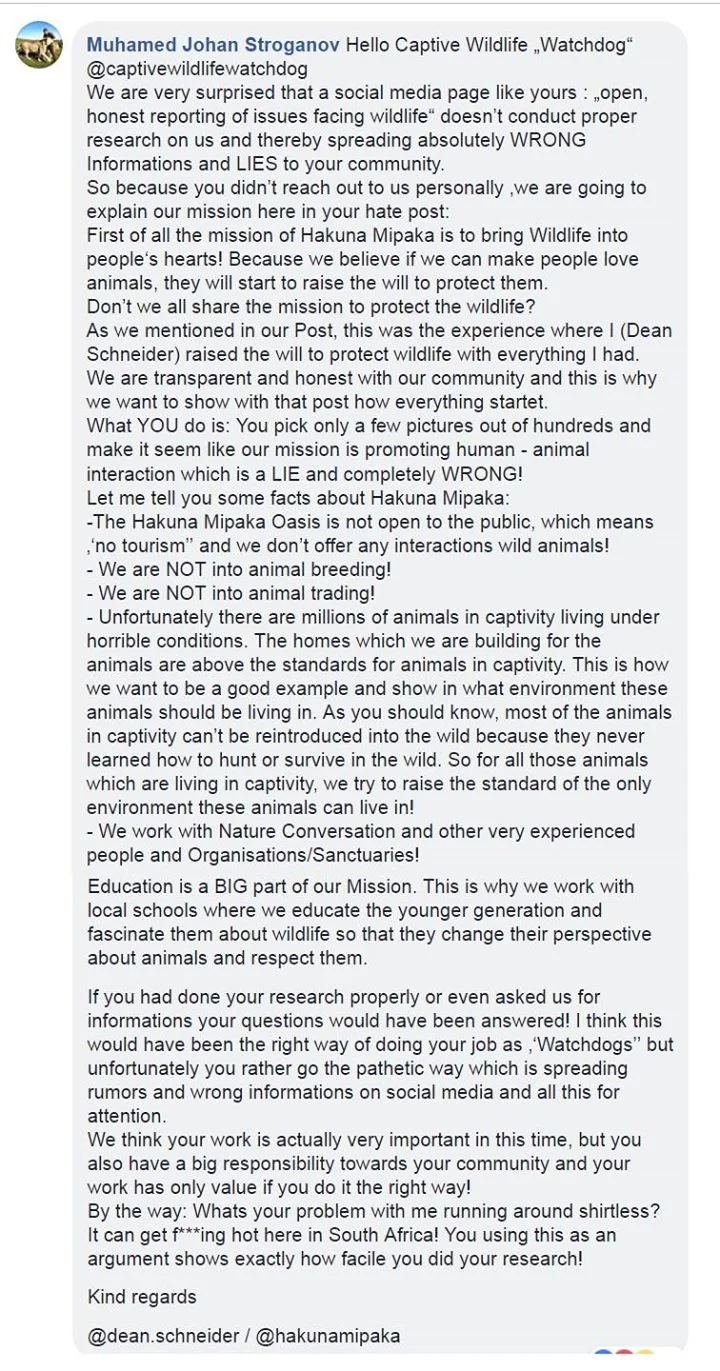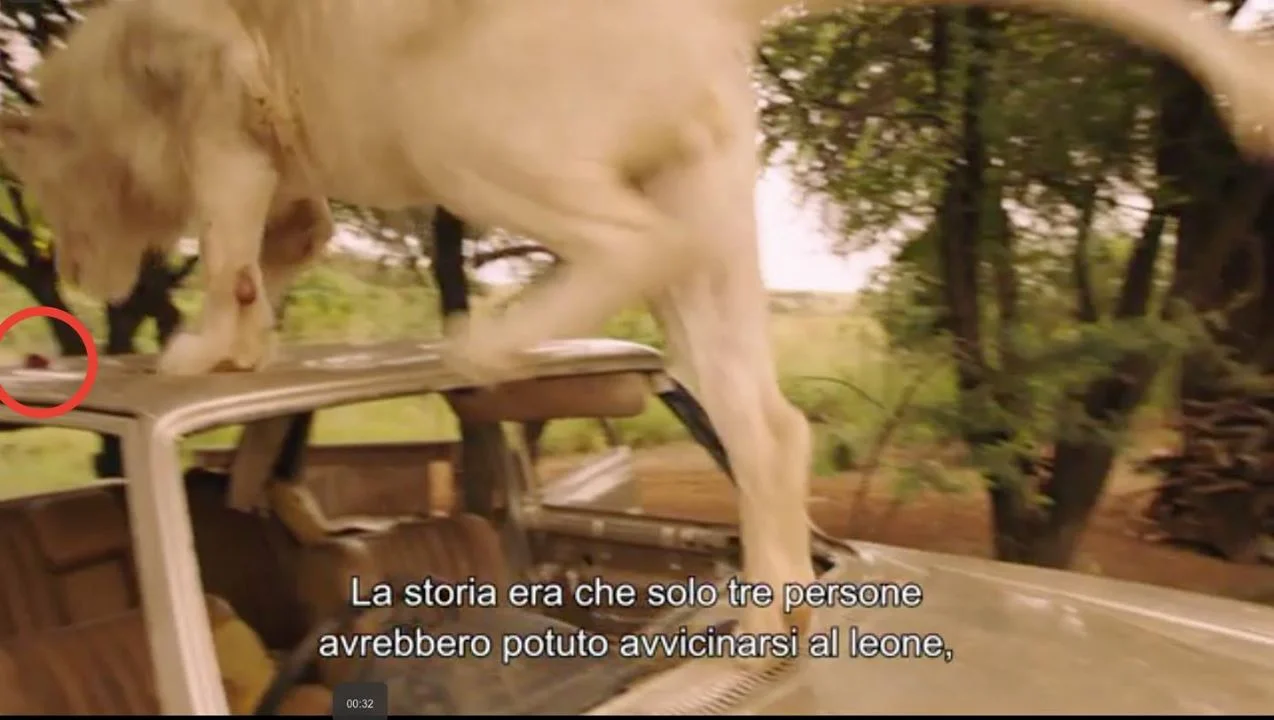Two recent incidents in the United States have gained widespread attention–in public opinion circles, and local news, if not nationally–and while each incident encapsulates very different tones, both represent one of the greatest challenges faced by wildlife advocates: the vast majority of humans see animals ad nothing more than wingmen to their main character. Whether it’s beloved domestic pets comforting us when we’re sad, providing us comic relief when we’re upset, or wildlife being used to validate us as ‘adventurers’ or ‘special people with special skills’, animals do not feature in their own stories. Rather they are only valued for the commodity they can provide to us.
The first case, which actually took place in late February, and only came to public light in early April involved a man named Cody Roberts, and took place in Wyoming. Roberts has since been described by various locals as just a normal guy. One letter to the editor opened with a dramatic statement painting Roberts as ‘a decent hard-working family man. He was absolutely heroic in saving the life of his wife, who was in a horrific snowmobile accident.’ The opening to the letter went on to say ‘she flipped and almost tore her leg off. Somehow he was able to control the bleeding and haul her back to the pickup by himself and then to the hospital.’
This referenced scene of attributed heroism is brimming with painful irony considering that in February 2024, Cody Roberts used a snow machine to intention chase down and repeatedly run over a female juvenile gray wolf, mangling it so badly it could not even fight back. Roberts then duct taped the wolf’s mouth shut, loaded it onto his snow machine, and hauled it back to town–just as one of his defenders states he had done in such ‘heroic’ actions with his wife. Only instead of seeking aid for the grievously injured young wolf. Roberts took the animal to a local bar where, for hours, he tortured it, posing with it for photos, putting a collar on it, kissing it for videos, offering others to take photos with it. When not being used as a prop for photos and videos, the young wolf was left lying in a corner, bleeding and slowing dying of internal injuries. There have been some reports that a shock collar was used on the animal, but those remain unsubstantiated. That a collar was put on it is evident in photos and videos but the type of collar is not clear. Eventually, after hours, Roberts dragged the juvenile wolf out behind the bar and either bludgeoned it to death or shot it, accounts vary on how it met it’s final end.
Perhaps the only thing more stomach-churning than the torture and abuse itself is the reaction of those who witnessed it, the reactions of the town, and the reactions of the state of Wyoming. They range from statements that are fully, aggressively supportive, stating all wolves should be killed Roberts did nothing wrong, to supportive of only Roberts while grudgingly admitting it wasn’t a great idea to bring the wolf to the bar and torture it, to virtual indifference that it happened at all. Official Wyoming state reaction ended up being an indifferent sort of shrug, fine of $250 USD with a sense of annoyed ‘What more do you want? We followed the laws about this’ to their few public issuances regarding the case.
And state officials did follow the laws.
The problem is, there literally are virtually no laws in the state of Wyoming in regard to protecting wolves or other predators. Although Wyoming’s Yellowstone area enjoys raking in around $35million dollars annually from wolf-related tourism, the state itself doesn’t care enough about the wolves themselves to put even basic abuse protection laws in place. As broken down in this article from Outside Online, the Republican led Wyoming Statehouse passed a bill in 2021 calling for the extermination of 90 percent of Wyoming’s wolf population–despite that it brings them $35million dollars annually. The bill passed was formulated on lies and misinformation designed to intentionally mislead voters, pushing the mythology of the ‘big bad wolf’ which most places of the world evolved past decades ago. Wyoming’s wolf laws differ from any other of any state inasmuch that they actually encourage cruelty towards wolves, rather than protecting them.
A thin rime of land around the perimeter of Yellowstone is the only area in which there is any regulation about killing wolves–not protecting from killing, merely regulation in how they’re killed. The rest of Wyoming in its entirety is a ‘predator zone’ where wolves can be killed in any manner, without reason, or justification. Multiple other Wyoming species fall into this category as well. As stated by Amaroq Weiss, Senior Wolf Advocate at the Center for Biological Diversity, “You could pull a wolf apart with horses in 85 percent of the state” and this would not be considered animal cruelty.
Repeat that slowly.
In Wyoming, it is not considered animal cruelty to capture a wolf, tie each leg to a horse, and tear it apart alive, and that is not considered animal cruelty by Wyoming state laws. In fact, running wolves down, then over with snow machines as Roberts did is considered a fun sport in Wyoming. It’s called ‘wolf whacking’. And it’s been going on for decades. Even in the aftermath of this recent incident, the very government agencies who you would expect to protect wildlife from such gross abuses can only offer up shrugs and insistence that it’s not their problem, and they cannot stop it.
For Wyoming, wolves are a disposable wing man. They make the state look amazing, they draw crowds int he millions to Wyoming’s Yellowstone National Park. They gather millions of online followers who eagerly track the movements of famous Yellowstone pack members. They also bring huge sums of money to things like The Yellowstone Wolf Project which funds studies on the wolves, as well as providing money to the park itself, a park which provides Wyoming with roughly $653millions dollars in economic benefits and 7,000 jobs annually.
And in research articles, after articles after articles, scientific study has shown that the existence of wolves in Wyoming has stabilized the entire ecosystem of Yellowstone park, allowed for the recovery of entire forests, and recovery of historical ecosystems which had been systemically damaged by elk overpopulation, and that wolves have actually strengthened the health of the elk populations, and increased their resilience to disease. Wolf tourism actually brings in about four times more in revenue annually than elk hunters, and has allowed venues which feared the arrival of wolves since they relied on elk hunters to make ends meet actually increase their operations. Where when they relied only on seasonal elk hunters in the past, they can now keep their establishments open year round for wolf-watchers.
And for all the fears about how wolves would ‘destroy’ the elk population if they were reintroduced to Yellowstone, the fact that without wolves, elk over populated and died off by the thousands in lean years, or in some cases were mass culled by humans preemptively. With the reintroduction of wolves, these mass starvation events stopped, as did the need for human management. Almost as if… wolves belonged there where they had been for millennia prior to humans eradicating them…
Yet for all of this, Wyoming does not care about wolves as living things, Wyoming does not care about wolves in regard to their value to the ecosystem, Wyoming does not care about wolves at all beyond their existence of a disposable wingman to the state. Since the repugnant actions of Cody Roberts a number of posts by Wyoming residents have protested that he doesn’t represent the state in its entirety, that Cody Roberts isn’t a an accurate representation of all Wyoming residents. But their protests ring hollow because actions speak louder than words, and those in power in the government of Wyoming, those who could enact laws protecting wolves from cruelty and abuse, laws that respected them for the unspeakable value they have in our world, were elected by the public of Wyoming. And Wyoming residents elected people into power who think it’s perfectly reasonable to allow thing like dismembering wolves alive. The reality is, residents of Wyoming don’t care what happens to wolves until they’re getting bad press about it. (In the case of this last linked article, CWW does not condone threatening establishments or residents do not do that, ever)
As of yet, it’s unclear what, if any, greater actions might be taken against Cody Roberts. In some respects, it is surprising that Roberts was even burdened with a fine by wildlife officials, considering he was not only known by the Wyoming Fish and Game Commission, but also employed by them, along with the Department Of Transportation, for various contracts. It seems impossible to believe they were not aware that he enjoyed engaging in ‘wolf whacking’ in his free time.
The second incident we will address had not so much to do with intentional cruelty as with an utter disconnect with the natural world, and complete indifference to the lasting damage that can be caused by a momentary choice. In North Carolina, a group of people noticed several small black bear cubs in a tree outside their apartment complex. It is 100% normal for female black bears to leave their cubs in trees, or other locations for hours at a time while they forage for food. What is not normal, are the actions the onlookers took, which was to physically rip one of the small cubs out of the tree (they tried valiantly to get both, but the second cub was in a better position to resist) then hoist the cub up in the air, squealing and jumping up and down with excitement and posing for photos. A word of warning, the video is disturbing, as evidenced by the horror of those filming the incident who recognized the abuse for what it was.
After managing to get multiple photos, the young woman holding the cub either throws, or drops it, apparently after having been bitten, though no mention of a bit was has been made. It is possible she was simply done with it, and tossed it to the ground. As the small cub had been pulled over a chainlink fence when it was forcibly dragged from the hiding spot where its mother had left it, it was unable to climb back over and escape. It was later captured by animal control and is being housed at a wildlife facility where it will hopefully survive and eventually be released. While early articles lamented the behavior, even national publications covered it, while some offered ‘bear etiquette’ information, there was no mention of what the repercussions for these actions might be.
Just days after the initial reports, we find out why possible charges or repercussions had not been mentioned initially. It is because due to North Carolina laws, there would not be any repercussions. At all. Subsequent articles specified that while wildlife officials investigated they would not be charging the people responsible for ripping a black bear cub away from its family, and nature. They did, articles specify, give the group a stern finger wag, though. So comforting for the terrorized bear cub…
Just as with Cody Roberts, the issue is that abusing animals in the way this group abused the bear cub, isn’t an issue at all, in the eyes of the current laws. North Carolina laws. As broken down with some wry wit in the first section an article by this publication’s ‘answer man’ the incident took place on private property, not publicly protected spaces, and per North Carolina law it’s only illegal to ‘capture and possess’ wildlife like black bears. But what defines ‘possess’ the term of confinement, etc. is not specified by law. A few minutes? A few hours? A few days? Generally it is only applied to cases where animals are being kept as pets, or held for purposes of trafficking and/or selling.
In this incident, the cub was only held for a few minutes, it was not removed from the area, it was ‘released’. So, no charges. North Carolina does have animal cruelty laws, both misdemeanor and felony. However, those laws require proof of ‘intent to harm’ and in this situation, the wildlife investigators state that they did not feel there was any ‘intent’ to harm the bear cubs. The statutes on animal cruelty do not address emotional distress or intent to separate the wildlife from its environment, or lasting impact, such as the orphaning of the cub in this case. The intent to physically rip a small bear cub from its natural environment, prevent it from getting back to nature, and force it to be a prop to serve human indulgence does not qualify for abuse, despite that the same small bear cub was also then thrown/dropped from standing height of a human, resulting in a limp upon capture.
Because using wildlife as our wingman, to make us look good, to make us money, to bring us attention and prestige is not illegal, or even frowned upon in the greater overview. Seeing animals as disposable commodities is not vilified, but rather excused, for any number of reasons. They were ignorant. They didn’t mean any harm. They thought it would be okay. The list goes on. Sometimes, even if the person causes great harm, as with the bear cubs in North Carolina, because they didn’t intentionally try to harm the animal by striking it, or handling it in an abusive way, it doesn’t count as abuse. Other times, even if the person intentionally tortures the wildlife, as with Cody Roberts in Wyoming, there literally are not any laws agains torturing animals. Either way, the result is the same. Wildlife is, by and large, nothing more than a disposable wing man to humans.
And until that changes, nothing else will change either.



















































































































































































































